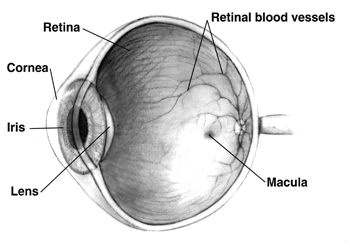Cataract
|
|
Cataract is also used to mean a waterfall or where the flow of a river changes dramatically. It comes from the Greek word meaning "downrush" or "to dash down" or the Latin "cataract" meaning a waterfall, a floodgate or a portcullis.
Human_eyesight_two_children_and_ball_with_cataract.jpg
A cataract is any opacity which develops in the crystalline lens of the eye or in its envelope. Cataracts form for a variety of reasons, including infrared and microwave exposure, secondary effects of diseases such as diabetes, or simply due to advanced age; they are usually a result of denaturation of lens proteins. Genetic factors are often a cause of congenital cataracts and may also play a role in predisposing someone to cataracts. Some cataract formation is to be expected in any person over the age of 70. Fully half of all people between the ages of 65 and 74 and about 70% of those over 75 have some cataract formation. Cataracts may also be produced by eye injury or physical trauma.
Cataracts may be partial or complete, stationary or progressive, hard or soft. An early technique to remove cataracts was couching, which involved using a thin needle or stick to remove the clouding. This technique is known to have existed in Roman times and continued to be used throughout the Middle Ages and continues to be used in underprivilleged "Third world" countries today.
The most effective and common treatment is cataract surgery to remove the cloudy lens. There are two types of surgery that can be used to remove cataracts, extra-capsular and intra-capsular surgery. Extra-capsular surgery consists of removing the lens but leaving the majority of the lens capsule intact. High frequency sound waves (phacoemulsification) are sometimes used to break up the lens before extraction. Intra-capsular surgery involves removing the entire lens of the eye, including the lens capsule, but it is rarely performed in modern practice. The lens is then replaced with a plastic lens (an intraocular lens implant) which remains permanently in the eye.
Cataract operations are mostly performed under a local anaesthetic and the patient will be allowed to go home the same day. Complications after cataract surgery are uncommon. Many people (up to 50%) can develop a posterior capsular opacification after initial cataract surgery. This is a thickening and clouding of the lens capsule (which was left behind when the cataract was removed) and it can be easily corrected using a laser to make holes in the capsule for the person to see through. Retinal detachment is an uncommon complication of cataract surgery.
Previously, polymethylmethacrylate was used as the lens material. Advances have brought about the use of silicone acrylate which is a soft material. This allows the lens to be folded and injected into the eye through a smaller incision. Acrylic lenses can also be used with small incisions and are a better choice in people who have a history of uveitis or are at high risk of retinal detachment. Acrylic is not always an ideal choice due to its added expense.
External links
- NHS Best Treatments Site (http://www.besttreatments.co.uk/btuk/electsurgery/cataract_surgery)
- eMedicine Health (http://www.emedicinehealth.com/articles/14319-1.asp)de:Grauer Star
id:Katarak it:Cataratta he:קטרקט ms:Katarak nl:Cataract ja:白内障 pl:Zaćma zh-cn:白内障 sv:Grå starr


